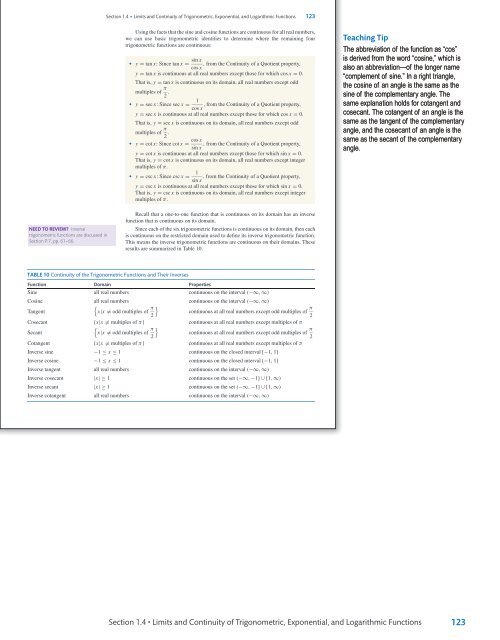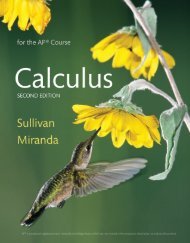Sullivan Microsite TE SAMPLE
Create successful ePaper yourself
Turn your PDF publications into a flip-book with our unique Google optimized e-Paper software.
<strong>Sullivan</strong> AP˙<strong>Sullivan</strong>˙Chapter01 October 8, 2016 17:4<br />
Section 1.4 • Limits and Continuity of Trigonometric, Exponential, and Logarithmic Functions 123<br />
Using the facts that the sine and cosine functions are continuous for all real numbers,<br />
we can use basic trigonometric identities to determine where the remaining four<br />
trigonometric functions are continuous:<br />
• y = tan x: Since tan x = sin x , from the Continuity of a Quotient property,<br />
cos x<br />
y = tan x is continuous at all real numbers except those for which cos x = 0.<br />
That is, y = tan x is continuous on its domain, all real numbers except odd<br />
multiples of π 2 .<br />
• y = sec x: Since sec x = 1 , from the Continuity of a Quotient property,<br />
cos x<br />
y = sec x is continuous at all real numbers except those for which cos x = 0.<br />
That is, y = sec x is continuous on its domain, all real numbers except odd<br />
multiples of π 2 .<br />
• y = cot x: Since cot x = cos x , from the Continuity of a Quotient property,<br />
sin x<br />
y = cot x is continuous at all real numbers except those for which sin x = 0.<br />
That is, y = cot x is continuous on its domain, all real numbers except integer<br />
multiples of π.<br />
• y = csc x: Since csc x = 1 , from the Continuity of a Quotient property,<br />
sin x<br />
y = csc x is continuous at all real numbers except those for which sin x = 0.<br />
That is, y = csc x is continuous on its domain, all real numbers except integer<br />
multiples of π.<br />
Teaching Tip<br />
The abbreviation of the function as “cos”<br />
is derived from the word “cosine,” which is<br />
also an abbreviation—of the longer name<br />
“complement of sine.” In a right triangle,<br />
the cosine of an angle is the same as the<br />
sine of the complementary angle. The<br />
same explanation holds for cotangent and<br />
cosecant. The cotangent of an angle is the<br />
same as the tangent of the complementary<br />
angle, and the cosecant of an angle is the<br />
same as the secant of the complementary<br />
angle.<br />
NEED TO REVIEW? Inverse<br />
trigonometric functions are discussed in<br />
Section P.7, pp. 61--66.<br />
Recall that a one-to-one function that is continuous on its domain has an inverse<br />
function that is continuous on its domain.<br />
Since each of the six trigonometric functions is continuous on its domain, then each<br />
is continuous on the restricted domain used to define its inverse trigonometric function.<br />
This means the inverse trigonometric functions are continuous on their domains. These<br />
results are summarized in Table 10.<br />
TABLE 10 Continuity of the Trigonometric Functions and Their Inverses<br />
Function Domain Properties<br />
Sine all real numbers continuous on the interval (−∞, ∞)<br />
Cosine all real numbers continuous on the interval (−∞, ∞)<br />
{<br />
Tangent<br />
x|x = odd multiples of π }<br />
continuous at all real numbers except odd multiples of π 2<br />
2<br />
Cosecant {x|x = multiples of π} continuous at all real numbers except multiples of π<br />
{<br />
Secant<br />
x|x = odd multiples of π }<br />
continuous at all real numbers except odd multiples of π 2<br />
2<br />
Cotangent {x|x = multiples of π} continuous at all real numbers except multiples of π<br />
Inverse sine −1 ≤ x ≤ 1 continuous on the closed interval [−1, 1]<br />
Inverse cosine −1 ≤ x ≤ 1 continuous on the closed interval [−1, 1]<br />
Inverse tangent all real numbers continuous on the interval (−∞, ∞)<br />
Inverse cosecant |x| ≥1 continuous on the set (−∞, −1] ∪ [1, ∞)<br />
Inverse secant |x| ≥1 continuous on the set (−∞, −1] ∪ [1, ∞)<br />
Inverse cotangent all real numbers continuous on the interval (−∞, ∞)<br />
Section 1.4 • Limits and Continuity of Trigonometric, Exponential, and Logarithmic Functions<br />
123<br />
<strong>TE</strong>_<strong>Sullivan</strong>_Chapter01_PART II.indd 6<br />
11/01/17 9:55 am




